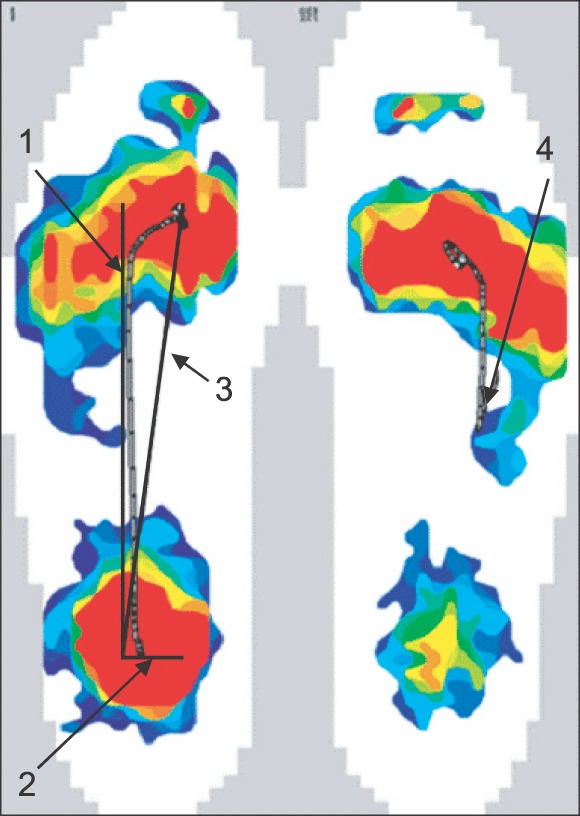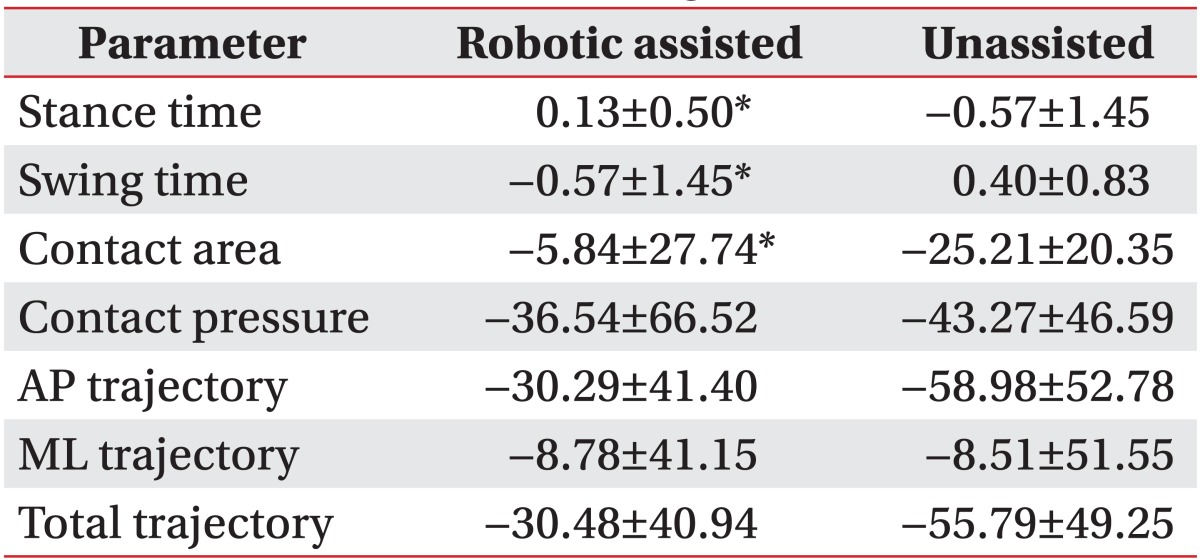1. Whitall J. Stroke rehabilitation research: time to answer more specific questions? Neurorehabil Neural Repair. 2004; 18:3–8. PMID:
15035958.

2. Bohannon RW, Horton MG, Wikholm JB. Importance of four variables of walking to patients with stroke. Int J Rehabil Res. 1991; 14:246–250. PMID:
1938039.

3. Belda-Lois JM, Mena-del Horno S, Bermejo-Bosch I, Moreno JC, Pons JL, Farina D, et al. Rehabilitation of gait after stroke: a review towards a top-down approach. J Neuroeng Rehabil. 2011; 8:66. PMID:
22165907.

4. Dohring ME, Daly JJ. Automatic synchronization of functional electrical stimulation and robotic assisted treadmill training. IEEE Trans Neural Syst Rehabil Eng. 2008; 16:310–313. PMID:
18586610.

5. Hidler J, Nichols D, Pelliccio M, Brady K. Advances in the understanding and treatment of stroke impairment using robotic devices. Top Stroke Rehabil. 2005; 12:22–35. PMID:
15940582.

6. Fasoli SE, Krebs HI, Stein J, Frontera WR, Hughes R, Hogan N. Robotic therapy for chronic motor impairments after stroke: follow-up results. Arch Phys Med Rehabil. 2004; 85:1106–1111. PMID:
15241758.

7. Mehrholz J, Werner C, Kugler J, Pohl M. Electromechanical-assisted training for walking after stroke. Cochrane Database Syst Rev. 2007; (4):CD006185. PMID:
17943893.

8. Neckel ND, Blonien N, Nichols D, Hidler J. Abnormal joint torque patterns exhibited by chronic stroke subjects while walking with a prescribed physiological gait pattern. J Neuroeng Rehabil. 2008; 5:19. PMID:
18761735.

9. Hidler J, Neckel N. Inverse-dynamics based assessment of gait using a robotic orthosis. Conf Proc IEEE Eng Med Biol Soc. 2006; 1:185–188. PMID:
17946800.

10. Park ES, Park CI, Kim JY, Park JW, Kim EJ. Foot pressure distribution and path of center of pressure (COP) of foot during ambulation in the children with spastic cerebral palsy. J Korean Acad Rehabil Med. 2002; 26:127–132.
11. Paik NJ, Im MS. The path of center of pressure (COP) of the foot during walking. J Korean Acad Rehabil Med. 1997; 21:762–771.
12. Ahroni JH, Boyko EJ, Forsberg R. Reliability of F-scan in-shoe measurements of plantar pressure. Foot Ankle Int. 1998; 19:668–673. PMID:
9801080.

13. Malouin F, Pichard L, Bonneau C, Durand A, Corriveau D. Evaluating motor recovery early after stroke: comparison of the Fugl-Meyer Assessment and the Motor Assessment Scale. Arch Phys Med Rehabil. 1994; 75:1206–1212. PMID:
7979930.

14. Holden MK, Gill KM, Magliozzi MR, Nathan J, Piehl-Baker L. Clinical gait assessment in the neurologically impaired: reliability and meaningfulness. Phys Ther. 1984; 64:35–40. PMID:
6691052.
15. Chen CY, Hong PW, Chen CL, Chou SW, Wu CY, Cheng PT, et al. Ground reaction force patterns in stroke patients with various degrees of motor recovery determined by plantar dynamic analysis. Chang Gung Med J. 2007; 30:62–72. PMID:
17477031.
16. Patterson KK, Gage WH, Brooks D, Black SE, McIlroy WE. Evaluation of gait symmetry after stroke: a comparison of current methods and recommendations for standardization. Gait Posture. 2010; 31:241–246. PMID:
19932621.

17. Kim DY, Park CI, Jang YW, Ahn SY, Na SI, Park YS. The relationship between weight-bearing and stiff-knee gait in hemiplegic patients. J Korean Acad Rehabil Med. 2004; 28:20–25.
18. Arcan M, Brull MA, Najenson T, Solzi P. FGP assessment of postural disorders during the process of rehabilitation. Scand J Rehabil Med. 1977; 9:165–168. PMID:
594697.
19. Wall JC, Ashburn A. Assessment of gait disability in hemiplegics: hemiplegic gait. Scand J Rehabil Med. 1979; 11:95–103. PMID:
493898.
20. Wall JC, Turnbull GI. Gait asymmetries in residual hemiplegia. Arch Phys Med Rehabil. 1986; 67:550–553. PMID:
3741082.
21. Chaudhuri S, Aruin AS. The effect of shoe lifts on static and dynamic postural control in individuals with hemiparesis. Arch Phys Med Rehabil. 2000; 81:1498–1503. PMID:
11083355.

22. Brunt D, Vander Linden DW, Behrman AL. The relation between limb loading and control parameters of gait initiation in persons with stroke. Arch Phys Med Rehabil. 1995; 76:627–634. PMID:
7605181.

23. Roerdink M, Beek PJ. Understanding inconsistent step-length asymmetries across hemiplegic stroke patients: impairments and compensatory gait. Neurorehabil Neural Repair. 2011; 25:253–258. PMID:
21041500.
24. Miyai I, Yagura H, Hatakenaka M, Oda I, Konishi I, Kubota K. Longitudinal optical imaging study for locomotor recovery after stroke. Stroke. 2003; 34:2866–2870. PMID:
14615624.

25. Hidler J, Nichols D, Pelliccio M, Brady K, Campbell DD, Kahn JH, et al. Multicenter randomized clinical trial evaluating the effectiveness of the Lokomat in subacute stroke. Neurorehabil Neural Repair. 2009; 23:5–13. PMID:
19109447.

26. Donelan JM, Shipman DW, Kram R, Kuo AD. Mechanical and metabolic requirements for active lateral stabilization in human walking. J Biomech. 2004; 37:827–835. PMID:
15111070.

27. Chisholm AE, Perry SD, McIlroy WE. Inter-limb centre of pressure symmetry during gait among stroke survivors. Gait Posture. 2011; 33:238–243. PMID:
21167716.

28. Colombo G, Joerg M, Schreier R, Dietz V. Treadmill training of paraplegic patients using a robotic orthosis. J Rehabil Res Dev. 2000; 37:693–700. PMID:
11321005.
29. Gottschall JS, Kram R. Energy cost and muscular activity required for propulsion during walking. J Appl Physiol (1985). 2003; 94:1766–1772. PMID:
12506042.
30. Israel JF, Campbell DD, Kahn JH, Hornby TG. Metabolic costs and muscle activity patterns during robotic-and therapist-assisted treadmill walking in individuals with incomplete spinal cord injury. Phys Ther. 2006; 86:1466–1478. PMID:
17079746.
31. Hidler JM, Wall AE. Alterations in muscle activation patterns during robotic-assisted walking. Clin Biomech (Bristol, Avon). 2005; 20:184–193.

32. Regnaux JP, Saremi K, Marehbian J, Bussel B, Dobkin BH. An accelerometry-based comparison of 2 robotic assistive devices for treadmill training of gait. Neurorehabil Neural Repair. 2008; 22:348–354. PMID:
18073325.

33. Perry J. The mechanics of walking in hemiplegia. Clin Orthop Relat Res. 1969; 63:23–31. PMID:
5769371.






 PDF
PDF ePub
ePub Citation
Citation Print
Print






 XML Download
XML Download